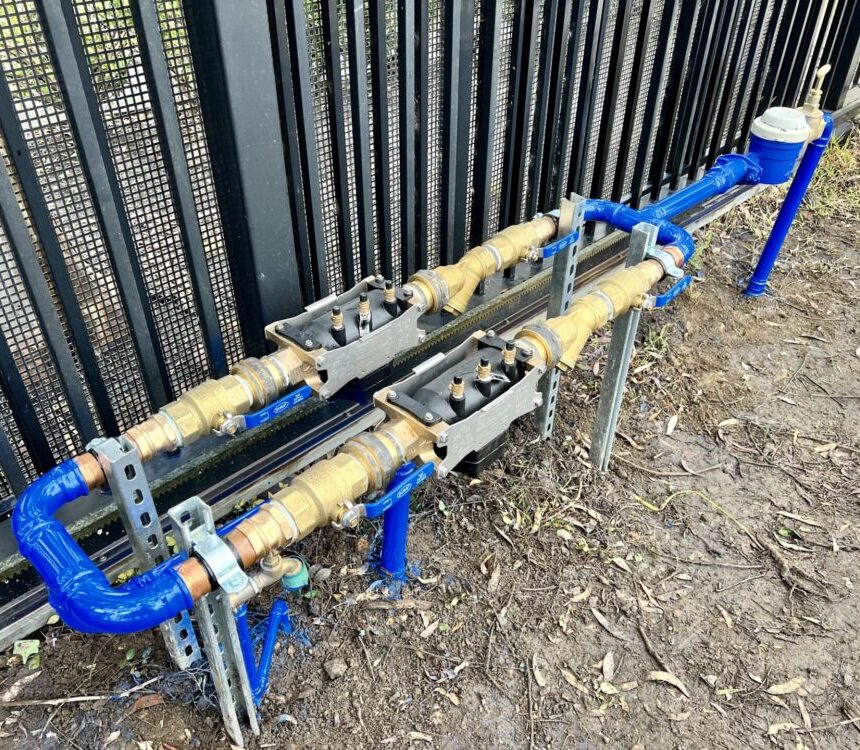What is backflow prevention in plumbing?
Backflow prevention in plumbing refers to the use of devices to stop contaminated water from reversing its flow and entering clean water supplies. These devices protect drinking water systems from pollutants.
Why is Legionella testing important?
Legionella testing is essential to identify and address bacteria in water systems before it causes harm. Regular testing ensures compliance with health regulations, prevents outbreaks, and safeguards the well-being of everyone using the water system.
What is Legionella, and why is it a concern for water systems?
Legionella is a type of bacteria that can cause severe respiratory illnesses, such as Legionnaires' disease. It thrives in water systems, including cooling towers, hot tubs, and plumbing systems. If not properly managed, Legionella can pose a significant health risk to individuals who come into contact with contaminated water droplets or aerosols.
How does Legionella bacteria spread in water systems?
Legionella bacteria can multiply and spread through water systems when conditions are favorable. It can enter the system through various sources, such as incoming water, external contamination, or the growth of biofilms. Once present, Legionella can multiply in warm water temperatures, stagnant water, or areas with inadequate disinfection or maintenance.
What are the health risks associated with Legionella contamination?
Legionella contamination can lead to serious illnesses, including Legionnaires' disease and Pontiac fever. Legionnaires' disease is a severe form of pneumonia that can cause high fever, cough, shortness of breath, muscle aches, and even death in severe cases. Pontiac fever is a milder flu-like illness caused by Legionella, with symptoms including fever, headache, and muscle aches.
What are the legal obligations for Legionella risk management?
The legal obligations for Legionella risk management vary by jurisdiction. However, many countries and regions have specific regulations and guidelines that businesses and organizations must follow. These often include conducting risk assessments, implementing control measures, maintaining accurate records, and regularly monitoring and maintaining water systems to prevent Legionella contamination.
How can I prevent Legionella contamination in my water systems?
Preventing Legionella contamination requires a comprehensive approach. It involves regular risk assessments, implementing control measures, ongoing monitoring, and proper maintenance of water systems. Some preventive measures include maintaining appropriate water temperatures, ensuring proper disinfection and cleaning procedures, controlling biofilm formation, and providing staff training on Legionella awareness and prevention.
What is a Legionella risk assessment, and why is it important?
A Legionella risk assessment is a thorough evaluation of water systems to identify potential sources and conditions that may support the growth and spread of Legionella bacteria. It helps to determine the level of risk and develop appropriate control measures. A risk assessment is important as it ensures compliance with regulations, identifies areas for improvement, and helps implement effective Legionella management strategies.
How often should water systems be monitored for Legionella?
The frequency of Legionella monitoring depends on various factors, including the type of water system, its usage, and the associated risk level. Generally, regular monitoring should be conducted at least every three to six months. However, high-risk systems, such as healthcare facilities or those with a history of Legionella issues, may require more frequent monitoring.
What steps should be taken in the event of a Legionella outbreak?
If a Legionella outbreak is suspected, immediate actions should be taken. This includes notifying relevant authorities, implementing control measures to limit further exposure, conducting thorough investigations to identify the source of contamination, and providing appropriate medical care to affected individuals. It is crucial to work with experienced professionals to manage and resolve the outbreak effectively.
How can ongoing training and education help prevent Legionella contamination?
Ongoing training and education play a vital role in preventing Legionella contamination. By providing staff with knowledge and awareness about Legionella, proper maintenance practices, and control measures, organizations can create a culture of vigilance. Training ensures that individuals understand their roles in preventing Legionella, promoting early detection, and taking necessary actions to mitigate risks effectively.
What is backflow prevention?
Backflow prevention is the process of preventing contaminated water from flowing back into the drinking water supply or into your plumbing system. Contaminated water can carry harmful bacteria, chemicals, or substances that can affect your health and safety.
Why do I need backflow prevention?
You need backflow prevention to protect your water quality and comply with the plumbing regulations in your area. Backflow prevention devices are required for any connection to the water main that has a potential risk of contamination, such as irrigation systems, fire sprinkler systems, swimming pools, spas, or industrial equipment.
What are the types of backflow prevention devices?
There are different types of backflow prevention devices depending on the level of hazard and the type of connection. Some common devices are:
- Air gap: an open vertical space between a water outlet and a water receptacle that prevents any backflow.
- Double check valve: a device that has two spring-loaded check valves that allow water to flow in one direction only.
- Reduced pressure zone device (RPZD): a device that has two check valves and a pressure relief valve that creates a zone of lower pressure between them. If any backflow occurs, the pressure relief valve opens and discharges the contaminated water to the atmosphere.
- Double check detector assembly (DCDA): a device that has a double check valve and a meter that detects any unauthorized water usage or leakage.
How does backflow occur and what are the consequences?
Backflow occurs when the flow of water in a plumbing system reverses its direction, potentially allowing non-potable water or other substances to enter the clean water supply. Backflow can happen due to a drop in water pressure, which can occur during events such as water main breaks, firefighting activities, or high water demand in nearby areas. When the pressure drops, it can create a siphoning effect, drawing water from a non-potable source back into the potable water system. Backflow can introduce contaminants such as chemicals, bacteria, fertilisers, or other hazardous substances into the drinking water supply. This can pose serious health risks to consumers and damage the plumbing infrastructure.
Where are backflow prevention devices required and who can install them?
Backflow prevention devices are commonly used in various settings, including residential buildings, commercial properties, industrial facilities, and public water systems. They are particularly crucial in locations where there is a higher risk of contamination, such as Hospitals, Healthcare Facilities, Schools, Laboratories, Chemical Plants, and Irrigation Systems. Local plumbing codes and regulations often require the installation of backflow prevention devices in specific situations. Trained professionals, such as licensed plumbers with backflow prevention accreditation, can assess the risk factors and determine the appropriate type of backflow prevention device to install based on the specific requirements and local regulations.
How often do I need to test my backflow prevention device?
You need to test your backflow prevention device at least once a year or more frequently if required by the water authority or the building authority. Testing ensures that the device is working properly and prevents any failure or leakage that could compromise your water quality. Only licensed plumbers with backflow prevention accreditation can test medium and high hazard backflow devices. They must submit a test report to the water authority or the building authority after testing the device.
What is a thermostatic mixing valve (TMV)?
A thermostatic mixing valve (TMV) is a valve that blends hot water with cold water to ensure constant, safe water outlet temperatures, preventing scalding or thermal shock. A TMV also shuts off rapidly in the event of a hot or cold water supply failure.
Why do I need a thermostatic mixing valve (TMV)?
You need a thermostatic mixing valve (TMV) to protect yourself and others from scalding injuries and to comply with the plumbing codes and regulations in your area. Scalding can occur when the water temperature exceeds 50°C, which can happen due to fluctuations in water pressure or demand. A TMV can regulate the water temperature to a safe level, usually between 38°C and 45°C, depending on the application.
What are the types of thermostatic mixing valves (TMVs)?
There are different types of thermostatic mixing valves (TMVs) depending on the level of hazard and the type of connection. Some common types are:
- Single point TMV: a valve that controls the water temperature at one outlet only, such as a shower or a basin.
- Multiple point TMV: a valve that controls the water temperature at several outlets within a zone or a building, such as a group of showers or basins.
- Thermostatic basin mixer: a tap that has a built-in TMV that controls the water temperature at the spout.
- Thermostatic shower mixer: a tap that has a built-in TMV that controls the water temperature at the shower head.
- Electronic TMV: a valve that uses sensors and electronic controls to regulate the water temperature and flow rate.
Where are thermostatic mixing valves (TMVs) required?
Thermostatic mixing valves (TMVs) are required for any plumbing fixture that delivers hot water for personal hygiene or washing purposes, such as showers, baths, basins, sinks, bidets, and spouts. They are particularly important in locations where there is a higher risk of scalding or infection, such as hospitals, healthcare facilities, schools, laboratories, aged care facilities, and childcare centres.
Who can install or service thermostatic mixing valves (TMVs)?
Only licensed plumbers with thermostatic mixing valve accreditation can install or service medium and high hazard TMVs. They must follow the manufacturer's specifications and the relevant standards and codes. They must also submit a commissioning or service report to the water authority or the building authority after installing or servicing the TMV.
How often do I need to service my thermostatic mixing valve (TMV)?
You need to service your thermostatic mixing valve (TMV) at least once a year or more frequently if required by the water authority or the building authority. Servicing ensures that the TMV is working properly and prevents any failure or leakage that could compromise your water quality and safety. Only licensed plumbers with thermostatic mixing valve accreditation can service medium and high hazard TMVs. They must submit a service report to the water authority or the building authority after servicing the TMV.





